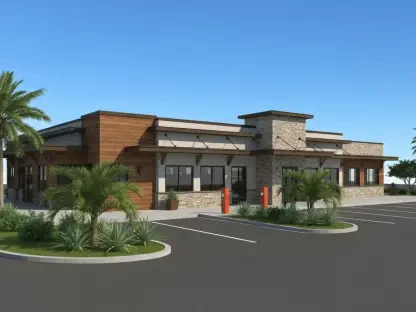What happens when a sprawling hotel must transform into the perfect setting for a 500-guest corporate gala with just 48 hours to spare? The pressure mounts as event managers scramble to align client expectations, seating arrangements, and safety protocols while ensuring every detail dazzles. In the high-stakes world of venue management, such scenarios are all too common, often teetering on the edge of chaos. Yet, a quiet revolution is underway, driven by floorplanning technology that promises to turn logistical nightmares into streamlined successes. This digital innovation is reshaping how venues tackle the complexities of event planning, offering tools to visualize, optimize, and execute with precision.
The significance of this shift cannot be overstated. As the hospitality industry grapples with rising client demands and increasingly intricate events, traditional pen-and-paper methods are proving inadequate. Floorplanning tech emerges as a lifeline, empowering venues to handle everything from intimate weddings to massive conferences with confidence. This article delves into how these tools are transforming event logistics, spotlighting real-world impacts, expert insights, and practical strategies for adoption. The focus remains on how technology bridges the gap between vision and reality, ensuring venues not only survive but thrive in a competitive landscape.
Why Event Logistics Challenge Venues
Managing events at any venue, whether a cozy restaurant or a vast convention center, often feels like orchestrating a high-wire act. A single oversight—be it a misplaced table blocking an emergency exit or a miscommunication about stage setup—can unravel months of preparation. Event managers must juggle diverse elements like decor, guest flow, and tight schedules, all while meeting client visions that sometimes shift at the last minute. The stakes are high, as a flaw in execution can tarnish a venue’s reputation in an instant.
Beyond these immediate pressures, the complexity of modern events adds another layer of difficulty. Clients today expect bespoke experiences tailored to unique themes, often requiring intricate layouts that push spatial limits. Add to this the need to comply with strict safety regulations and coordinate multiple teams, and the task becomes daunting. Venues are under constant scrutiny to deliver flawlessly, making the margin for error razor-thin in an industry where perfection is the baseline.
The Rising Demand for Tech in Event Management
As the hospitality sector evolves, precision and customization have become non-negotiable benchmarks for success. Event logistics now involve a web of variables, from diverse venue configurations to heightened expectations for personalized touches. Manual planning methods, once sufficient, struggle to keep pace with this fast-moving environment, often leading to inefficiencies or costly mistakes. The industry’s digital transformation is no longer optional but a critical response to these mounting challenges.
Floorplanning technology stands at the forefront of this change, offering venues a competitive edge. With safety codes tightening and operational efficiency under the spotlight, digital tools provide a way to navigate complexity with accuracy. A study by the Hospitality Technology Network indicates that over 60% of venue managers adopting digital planning tools report improved client satisfaction since integrating them into workflows starting in 2025. This trend underscores a broader shift toward tech-driven solutions to meet both practical needs and market demands.
How Floorplanning Tech Solves Logistical Pain Points
Floorplanning technology directly targets the core hurdles venues face, starting with visualization. Tools like 2D and 3D software enable planners to create detailed layouts, turning abstract concepts into tangible designs. This means seating charts, decor placements, and staging can be previewed and refined long before setup begins, eliminating guesswork and ensuring every element aligns with the client’s vision.
Space optimization is another critical benefit, allowing venues to make the most of every square foot. Digital plans help balance guest comfort with accessibility, ensuring pathways remain clear and overcrowding is avoided. Safety and compliance also get a boost, as these tools map out emergency exits and adhere to regulatory standards, providing peace of mind. For instance, a large hotel hosting a trade show can use such software to ensure fire code compliance while accommodating hundreds of attendees.
Adaptability rounds out the advantages, enabling rapid adjustments when plans shift. Consider a conference venue facing a sudden increase in attendees; floorplanning tech allows for quick reconfiguration of seating and catering zones without derailing the event. These tools act as a dynamic blueprint, supporting last-minute changes with ease and maintaining smooth operations under pressure.
Industry Perspectives on Floorplanning Tools
Insights from hospitality professionals reveal the tangible impact of floorplanning technology on event execution. Experts note that platforms offering 3D renderings have become game-changers, particularly for restaurants and unique spaces where spatial constraints are common. One venue manager shared how such a tool helped secure a major booking by presenting a detailed layout that addressed a client’s specific concerns about guest flow, building instant trust.
Anecdotal evidence further illustrates the value of these solutions. A wedding planner recounted using a digital floor plan to win over a skeptical couple by showcasing a dream setup complete with a dance floor and floral arrangements in vivid detail. This visual assurance turned hesitation into enthusiasm, sealing the deal. Industry data supports this momentum, with adoption rates of digital planning tools climbing steadily among venues since 2025, reflecting their growing role in elevating event standards.
Actionable Steps for Venues to Adopt Floorplanning Tech
For venues ready to embrace this technology, selecting the right software is the first step. Opt for platforms that offer both 2D and 3D visualization capabilities to cater to a range of event types, ensuring ease of use for staff at all levels. Compatibility with existing systems also matters, as seamless integration minimizes learning curves and boosts efficiency from day one.
Collaboration is key to maximizing these tools, so use them as a central hub for communication. Share digital layouts with clients, catering teams, and audiovisual crews to align everyone on the plan, reducing the risk of missteps. Additionally, leverage visualizations to upsell premium features like enhanced decor or exclusive lounge areas, turning a planning tool into a revenue driver. Finally, build contingency scenarios within the software to prepare for unexpected changes, ensuring events remain fluid even when surprises arise.
Looking back, the journey of floorplanning technology in reshaping event logistics has been marked by transformative strides. Venues that adopted these tools found themselves better equipped to handle the intricacies of modern events, from visualization to last-minute pivots. The path forward lies in continued integration, with managers encouraged to explore emerging features and train teams for optimal use. As the industry evolves, staying ahead means embracing digital solutions not just as aids, but as essential partners in crafting unforgettable experiences.









